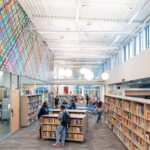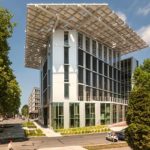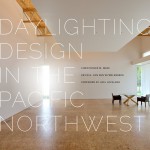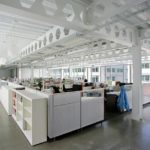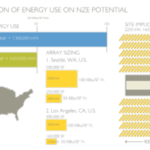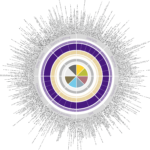Discovery Through Research
The Integrated Design Lab carries out research to advance knowledge and policies that support the healthiest and highest performing buildings and cities. It measures and analyzes modeled and actual building performance data in order to influence the building industry’s understanding of how to radically improve the design and operation performance of buildings. Our performance research includes energy efficiency, daylighting, electric lighting, occupant energy use behavior, human health and productivity in buildings, and advanced building management systems.
Our Areas of Research
The IDL analyzes building data and examines what impacts design, construction, and operation have on energy use and greenhouse gas emissions. The following are example projects and activities:
Pacific Northwest Building Training and Assessment Center (PNW BTAC)

The UW IDL was awarded a grant through the Bipartisan Infrastructure Law and the US Department of Energy in their Industrial Assessment Center (IAC) and Building Training and Assessment Centers (BTAC) Program to establish a new Pacific Northwest Building Training and Assessment Center (PNW BTAC). The PNW BTAC will network existing higher-education programs and technical…
NEEA BetterBricks Energy Efficient Technologies

The UW IDL developed three case studies of groundbreaking implementation of Luminaire Level Lighting Controls (LLLCs) for the Northwest Energy Efficiency Alliance. Projects included the Madrona Elementary School (Mahlum Architects), UW Founder’s Hall (LMN Architects), and Star Lake Elementary/Totem Middle School (McGranahan Architects). The case studies highlighted learning and synthesis of best practices for individually…
Seattle Building Tune-Up Accelerator
As part of a team that was awarded a $3.1 million, three-year grant from the US Department of Energy, Prof. Meek led implementation of a municipal-scale building-owner engagement and technical assistance process aimed at accelerating voluntary deep energy retrofits (20- 50% carbon emissions reductions) in the existing medium-sized (approximately 20,000-100,000ft²) commercial building stock in Seattle,…
Bullitt Center Energy Analysis

The UW IDL has performed comprehensive operational energy performance data measurement, verification, and documentation of the Bullitt Center, a five-story net-zero energy “Living Building” in Seattle, WA. The building achieves performance goals through multiple integrated strategies incorporating technologies, systems, and human behavior. Data collection included evaluating end-use energy, renewables, passive systems operation, light and comprehensive…
Daylighting, Windows, Dynamic Shading, and Lighting Systems
The Integrated Design Lab provides academic and applied research in the area of windows, daylighting, solar control, and visual comfort. This includes primary research focused on visual comfort and the experience of daylight in buildings, dynamic shading systems, emerging window technology, and electric lighting and controls. We have extensive experience with lighting and daylighting system performance audits and user experience surveys. Further, we provide project-based research for design teams in the Puget Sound Region and nationally with a focus on daylighting design, building system performance analysis, with an aim to support and shape design teams’ vision and to raise the bar for building performance and professional practice in the area of lighting and integrated design. We have experience on a broad range of building types including commercial, institutional, educational and industrial projects. We have extensive expertise in the simulation and analysis of both instantaneous and annual daylighting performance and electric lighting and controls integration and with the simulation and performance dynamic shading and façade systems. The lab includes a library of glazing and material samples, light redirecting technology, window coverings, and solar control products.
Facilities for Physical Models
Our facility includes a tilting earth heliodon, mirror-box overcast sky simulator, along with an array of digital simulation tools, photometric measuring equipment, data acquisition systems and tools for specialized photography. Access to the Materials and Daylighting Lab (MAD Lab) is by appointment and is located in Gould Hall on the University of Washington campus.
IDL research in the area of daylighting, windows, and solar control components has been funded through partnerships with the Northwest Energy Efficiency Alliance (NEEA), the National Science Foundation (NSF), the US Department of Energy (US DOE), New Buildings Institute (NBI), the New York State Energy Research and Development Authority (NYSERDA), Puget Sound Energy (PSE), Tacoma Power, Seattle City Light (SCL), and numerous building owners and designers.
For more information contact Chris Meek.
Daylighting Design in the Pacific Northwest

In addition to conserving energy, the use of daylight in architecture can be a powerful aesthetic tool. The effective employment of natural lighting is an important component of sustainable design, and some of the best work in this area comes from the Northwest. This practice-based book focuses on fourteen projects ranging from schools to community…
Daylighting Pattern Guide

Daylighting Pattern Guide The UW Integrated Design Lab partnered with the New Buildings Institute (NBI) and University of Idaho’s Integrated Design Lab to develop a free interactive tool available for applying proven daylighting strategies in a variety of building types. The Daylighting Pattern Guide illustrates how to create successful daylighting designs and presents information in…
Hospitals are a disproportionate energy consumer using the second greatest amount of energy per square foot in the US. With growing attention to climate change, decarbonization, and energy efficiency, we are working toward the goal of significantly reducing the environmental footprint of hospitals. Using energy simulation tools and existing precedents, we developing tools that aid our partners in achieving groundbreaking energy and decarbonization goals including the 2030 challenge and beyond.
The Integrated Design Lab works with design teams and healthcare system partners in the Pacific Northwest to assist with energy goal setting, strategy selection, and quantification of energy performance. Our aim is to provide an integrated project delivery and operations approach that increases the quality of the work and healing environment and significantly reduces energy use in healthcare settings.
For more information contact Heather Burpee.
Targeting 100!

Targeting 100! Regions and Cities Map Targeting 100! has become a widely recognized research project and roadmap nationally and has been foundational in helping to develop the conversation and implementation around energy efficiency in the healthcare sector. Learn more by downloading the full report or explore the Targeting 100! webtool. This webtool is an archive…
How U.S. hospitals can realize net-zero energy

Hospitals can reduce energy use with the aim of achieving net-zero energy (NZE). Insights from hospitals that are on the path to NZE and other buildings that have realized this goal help identify barriers and help identify next steps for the healthcare sector to design-toward and achieve NZE. This paper contextualizes hospital energy use in…
Our research explores the intersection of environmental health and human health and provides access to evidence that supports the application of healthier buildings.
Rosetta Stone: A Translational Tool for Research Informed Practice

The Rosetta Stone Translational Tool for Research-informed Practice is a joint collaboration between the University of Washington’s Integrated Design Lab (UW IDL) and design industry partners. The tool developed out of a collective desire to clearly communicate the synergies of high performance design, in a way that is backed by research and evidence. Learn more about…
AIA Design and Health Research Consortium

The Integrated Design Lab is part of a University of Washington interdisciplinary team recently selected to join the AIA Design and Health Research Consortium, an initiative seeking to further research and recognition of the strong influence of design on public health. Over a three-year period, the American Institute of Architects (AIA) and the Architects Foundation…
Health Impacts of Green Buildings

The built environment impacts health in multiple dimensions, from large infrastructure to the microscopic molecules and organisms that are not seen or perceived in daily life. In light of the complex interaction between various health-related impacts of the built environment, this publication has taken a multi-disciplinary approach using the Bullitt Center as a pilot project to…

